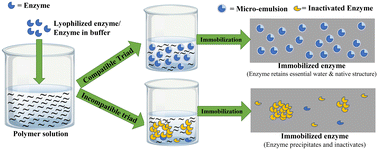Enzyme immobilization: polymer–solvent–enzyme compatibility
Abstract
Immobilization improves enzyme stability, allows easy enzyme separation from reaction mixtures, and enables repeatable use over prolonged periods, especially in systems requiring continuous chemical reactions. Immobilization also delivers enzymes for controlled release or promotes triggered degradation of entrapping materials. Polymeric materials in different physical forms, such as films, beads, coatings, and fibers, are increasingly used as support matrices for enzyme immobilization because they are easily fabricated and offer excellent mechanical versatility. Enzymes are generally compatible with water environments and can be mixed with water-soluble polymers and dried to produce immobilized enzyme products. However, while important, the utility of such water-soluble materials is limited. Many durable polymers, especially synthetic polymers, are intrinsically hydrophobic and not water-soluble. They are processed into different shapes by melting or solubilizing them in organic solvents. However, enzymes may denature in the presence of organic solvents or at elevated temperatures, limiting how enzymes can be combined with hydrophobic polymers. Fortunately, research has revealed several approaches for successful enzyme incorporation into polymer matrices that rely on solution processing with organic solvents. This review discusses strategies for producing immobilized enzymes by solution processing methods. Compatible polymer–solvent–enzyme triads that span aqueous and non-aqueous fabrication requirements are identified. Finally, based on the existing research on enzyme immobilization using enzyme compatible polymer solutions, prospects for future developments are summarized.



 Please wait while we load your content...
Please wait while we load your content...